The nuclear and adherent junction complex component protein ubinuclein negatively regulates the productive cycle of Epstein-Barr virus in epithelial cells
- PMID: 21084479
- PMCID: PMC3020007
- DOI: 10.1128/JVI.01397-10
The nuclear and adherent junction complex component protein ubinuclein negatively regulates the productive cycle of Epstein-Barr virus in epithelial cells
Abstract
The Epstein-Barr Virus (EBV) productive cycle is initiated by the expression of the viral trans-activator EB1 (also called Zebra, Zta, or BZLF1), which belongs to the basic leucine zipper transcription factor family. We have previously identified the cellular NACos (nuclear and adherent junction complex components) protein ubinuclein (Ubn-1) as a partner for EB1, but the function of this complex has never been studied. Here, we have evaluated the consequences of this interaction on the EBV productive cycle and find that Ubn-1 overexpression represses the EBV productive cycle whereas Ubn-1 downregulation by short hairpin RNA (shRNA) increases virus production. By a chromatin immunoprecipitation (ChIP) assay, we show that Ubn-1 blocks EB1-DNA interaction. We also show that in epithelial cells, relocalization and sequestration of Ubn-1 to the tight junctions of nondividing cells allow increased activation of the productive cycle. We propose a model in which Ubn-1 is a modulator of the EBV productive cycle: in proliferating epithelial cells, Ubn-1 is nuclear and inhibits activation of the productive cycle, whereas in differentiated cells, Ubn-1 is sequestrated to tight junctions, thereby allowing EB1 to fully function in the nucleus.
Figures

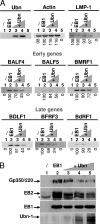
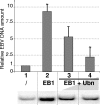
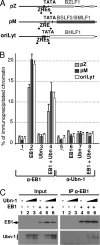
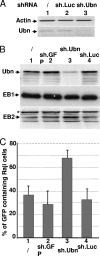

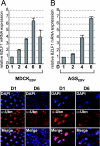

Similar articles
-
Epstein-Barr virus (EBV) EB1/Zta protein provided in trans and competent for the activation of productive cycle genes does not activate the BZLF1 gene in the EBV genome.J Gen Virol. 1996 Mar;77 ( Pt 3):501-9. doi: 10.1099/0022-1317-77-3-501. J Gen Virol. 1996. PMID: 8601788
-
Identification of new interacting partners of the shuttling protein ubinuclein (Ubn-1).Exp Cell Res. 2012 Mar 10;318(5):509-20. doi: 10.1016/j.yexcr.2011.12.020. Epub 2012 Jan 4. Exp Cell Res. 2012. PMID: 22245583
-
Repression of CIITA by the Epstein-Barr virus transcription factor Zta is independent of its dimerization and DNA binding.J Gen Virol. 2016 Mar;97(3):725-732. doi: 10.1099/jgv.0.000369. Epub 2015 Dec 11. J Gen Virol. 2016. PMID: 26653871 Free PMC article.
-
Regulation of cellular and viral protein expression by the Epstein-Barr virus transcriptional regulator Zta: implications for therapy of EBV associated tumors.Cancer Biol Ther. 2009 Jun;8(11):987-95. doi: 10.4161/cbt.8.11.8369. Epub 2009 Jun 10. Cancer Biol Ther. 2009. PMID: 19448399 Review.
-
Lytic cycle switches of oncogenic human gammaherpesviruses.Adv Cancer Res. 2007;97:81-109. doi: 10.1016/S0065-230X(06)97004-3. Adv Cancer Res. 2007. PMID: 17419942 Review.
Cited by
-
Histone chaperone HIRA deposits histone H3.3 onto foreign viral DNA and contributes to anti-viral intrinsic immunity.Nucleic Acids Res. 2017 Nov 16;45(20):11673-11683. doi: 10.1093/nar/gkx771. Nucleic Acids Res. 2017. PMID: 28981850 Free PMC article.
-
Temporal Expression of Peripheral Blood Leukocyte Biomarkers in a Macaca fascicularis Infection Model of Tuberculosis; Comparison with Human Datasets and Analysis with Parametric/Non-parametric Tools for Improved Diagnostic Biomarker Identification.PLoS One. 2016 May 26;11(5):e0154320. doi: 10.1371/journal.pone.0154320. eCollection 2016. PLoS One. 2016. PMID: 27228113 Free PMC article.
-
Fatal attraction: The roles of ribosomal proteins in the viral life cycle.Wiley Interdiscip Rev RNA. 2021 Mar;12(2):e1613. doi: 10.1002/wrna.1613. Epub 2020 Jul 12. Wiley Interdiscip Rev RNA. 2021. PMID: 32657002 Free PMC article. Review.
-
The Epstein-Barr virus BcRF1 gene product is a TBP-like protein with an essential role in late gene expression.J Virol. 2012 Jun;86(11):6023-32. doi: 10.1128/JVI.00159-12. Epub 2012 Mar 28. J Virol. 2012. PMID: 22457524 Free PMC article.
References
-
- Adamson, A. L., D. Darr, E. Holley-Guthrie, R. A. Johnson, A. Mauser, J. Swenson, and S. Kenney. 2000. Epstein-Barr virus immediate-early proteins BZLF1 and BRLF1 activate the ATF2 transcription factor by increasing the levels of phosphorylated p38 and c-Jun N-terminal kinases. J. Virol. 74:1224-1233. - PMC - PubMed
-
- Aho, S., J. Lupo, P. A. Coly, A. Sabine, M. Castellazzi, P. Morand, A. Sergeant, E. Manet, V. Boyer, and H. Gruffat. 2009. Characterization of the ubinuclein protein as a new member of the nuclear and adhesion complex components (NACos). Biol. Cell 101:319-334. - PubMed
-
- Babcock, G. J., L. L. Decker, M. Volk, and D. A. Thorley-Lawson. 1998. EBV persistence in memory B cells in vivo. Immunity 9:395-404. - PubMed
Publication types
MeSH terms
Substances
LinkOut - more resources
Full Text Sources
Molecular Biology Databases

